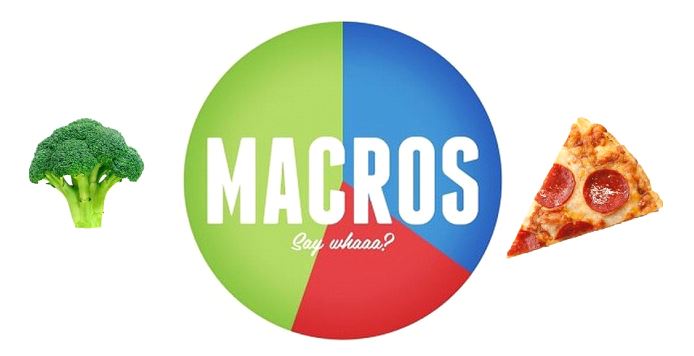This one has a bit more body to it. We’re going to look at macro-nutrients or “macros”.
All food stuffs are made up of three macro-nutrient groups: protein, fat, and carbohydrate. Each of these macro-nutrients are essential to the healthy function of our bodies. Let’s have a look at what each of them does and why we need them:
PROTEINS – Proteins are essential nutrients for the human body. They are one of the building blocks of body tissue and can also serve as a fuel source.
Here are a couple of lists to help you get your head around the foods that contain protein and how much they contain. Note: 3oz = 85g, 1oz = 28g, 1 cup = 237ml.


FATS – Fats are a type of nutrient that you get from your diet. It is essential to eat some fats, though it is also harmful to eat too many.
The fats you eat give your body energy that it needs to work properly. During exercise, your body uses calories from carbohydrates you have eaten. But after 20 minutes, exercise then depends on calories from fat to keep you going.
You also need fat to keep your skin and hair healthy. Fat also helps you absorb vitamins A, D, E, and K, the so-called fat-soluble vitamins. Fat also fills your fat cells and insulates your body to help keep you warm.
The fats your body gets from your food give your body essential fatty acids called linoleic and linolenic acid. They are called “essential” because your body cannot make them itself, or work without them. Your body needs them for brain development, controlling inflammation, and blood clotting.
Fat has 9 calories per gram, more than 2 times the number of calories in carbohydrates and protein, which each have 4 calories per gram.
All fats are made up of saturated and unsaturated fatty acids. Fats are called saturated or unsaturated depending on how much of each type of fatty acid they contain.

CARBOHYDRATES – One of the primary functions of carbohydrates is to provide your body with energy with the majority of carbs being digested and broken down into glucose before entering the blood stream.
The glucose in the blood is taken up into the cells of the body and used to produce ATP (a fuel molecule) through cellular respiration. The cells then use ATP to power a variety of metabolic tasks.
ATP can be produced from several source, including dietary carbs and fats. If you eat a mix of these nutrients, the majority of your body’s cells will prefer to use carbs as their primary energy source.
Excess glucose can be stored for later use. This stored form of glucose is called glycogen and is found in the liver and muscle. In the liver, these molecules can be released into the blood to provide energy throughout the body and help maintain normal blood sugar levels between meals.
The glycogen stored in the muscles can only be used by the muscle cells; it is vital for use during long periods of high intensity exercise.
WHEN YOUR BODY HAS ALL OF THE GLUCOSE IT NEEDS AND YOUR GLYCOGEN STORES ARE FULL, YOUR BODY CAN CONVERT EXCESS CARBS INTO TRIGLYCERIDE MOLECULES AND STORE THEM AS FAT.
Glycogen stores are vital to ensure that the body has enough glucose for all of it’s functions.
Carbohydrates are not the enemy when it comes to weight loss but you do need to choose the right ones. Here’s a list of the best carbohydrate choices:
- Vegetables: All of them. It is best to eat a variety of vegetables every day.
- Whole fruits: Apples, bananas, strawberries, etc.
- Legumes: Lentils, kidney beans, peas, etc.
- Nuts: Almonds, walnuts, hazelnuts, macadamia nuts, peanuts, etc.
- Seeds: Chia seeds, pumpkin seeds.
- Whole grains: Choose grains that are truly whole, as in pure oats, quinoa, brown rice, etc.
- Tubers: Potatoes, sweet potatoes, etc.
Now, using MyFitnessPal I would like you to set your macro goals. You do this by going into the menu -> Goals -> Calorie, Carbs, Protein and Fat Goals -> input your calories at your specific allowance, then toggle the macros to 40% Carbs, 30% Protein, and 30% Fat. Click the tick and that should be your new goals saved. You can monitor these goals throughout each day by clicking into the nutrition section of the diary.
Carbohydrates contain around 4 calories per gram, proteins are also 4 calories per gram, and fats contain 9 calories per gram.
Note: your nutritional goals will automatically adjust through the day if you have your fitness tracker linked to your MyFitnessPal account. Ideally, I would like to you stick to your original allowances and not use the burned calories that the app automatically applies. Eg. if your calorie goal is 1500 calories and your doing the 40/30/30 ratio of macros then you should be only consuming the 1500 calories through 600 calories from carbohydrates (600/4=150g), 450 calories from protein (450/4=112.5g), and 450 calories from fat (450/9=50g). Ignore the auto-adjustments.


Leave a comment